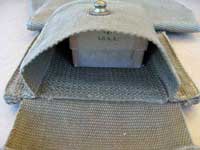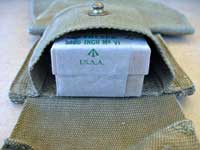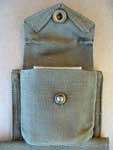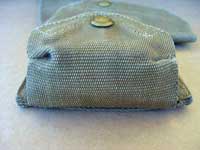| Karkee Web Home Page | Officer's Main Page | W.E.O. Main Page | W.E.I.O. Main Page |
Web Equipment, Infantry Officers
Equipment Carriers
As with the 1916 pattern, the weave pattern of Mills Equipment for Officers was fine, involving singled warp threads, rather than the usual doubled threads.
HOLSTER, PISTOL, with POUCH, AMMUNITION, PISTOL (.455-in. Webley, with 6 inch barrel)
HOLSTER, PISTOL, with POUCH, AMMUNITION, PISTOL (455-in. Webley, with 4 inch barrel)
HOLSTER, PISTOL, with POUCH, AMMUNITION, PISTOL (non-standard revolvers, or pistols)
(Issues 1 to 3)
 Mills offered sized holsters for Webley .455-in. Pistol, revolver, No. 1, Mark VI with either 4, or 6-inch barrels. They also offered variants for other weapons, contingent on the officer supplying a tracing of the weapon, together with dimensions. The flat form of the 1916 pattern was modified to that of Patt. ’19 W.E., with a wooden “cotton reel” fitted into the muzzle end, secured with brass, dome headed nails. The Ammunition pouch first had the same hooded flap as it did in 1916, but was later changed to a box-lid, matching the Compass pocket. As with the Binocular Case, the Holster and Ammunition pouch could not be disassembled, as in W.E., R.A. The detail at right above shows, left to right: Ammunition pouch flap (hooded), 1916 pattern; Ammunition pouch flap (hooded), 1st issue W.E., I.O.; Ammunition pouch flap (box-lid) , 2nd issue W.E., I.O. Photos are © Paul Hannon 2010 (near right), © Terry Hawker 2010 (centre right), and © Nick Wall 2009 (far right).
Mills offered sized holsters for Webley .455-in. Pistol, revolver, No. 1, Mark VI with either 4, or 6-inch barrels. They also offered variants for other weapons, contingent on the officer supplying a tracing of the weapon, together with dimensions. The flat form of the 1916 pattern was modified to that of Patt. ’19 W.E., with a wooden “cotton reel” fitted into the muzzle end, secured with brass, dome headed nails. The Ammunition pouch first had the same hooded flap as it did in 1916, but was later changed to a box-lid, matching the Compass pocket. As with the Binocular Case, the Holster and Ammunition pouch could not be disassembled, as in W.E., R.A. The detail at right above shows, left to right: Ammunition pouch flap (hooded), 1916 pattern; Ammunition pouch flap (hooded), 1st issue W.E., I.O.; Ammunition pouch flap (box-lid) , 2nd issue W.E., I.O. Photos are © Paul Hannon 2010 (near right), © Terry Hawker 2010 (centre right), and © Nick Wall 2009 (far right).
The form of Mills holsters had been fixed, by their weaving techniques, as two flat tubes, of dissimilar sizes, woven in one operation, with the under-trigger section left as threads to be cut off, the edges turned in and stitched. No departures from this angular form have ever been noted, in order to accommodate non-Webley items. Between the Wars, it is un-likely that officers bought anything more exotic than the Mark VI Webley, although one set of Regimental Orders mentions Marching Order as including “…revolver, or automatic…”. Of these, no holster sized for a 4-inch barrel has yet been noted.

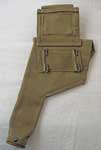
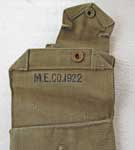 The 1st Issue Holster, pistol substituted a wooden “cotton reel”, secured into the open muzzle section with dome-headed brass nails. The Ammunition pocket was still fitted with a hooded flap. This Holster is maker marked "M.E. Co." and dated 1922. From the Terry Hawker Collection, photographs © Terry Hawker 2010.
The 1st Issue Holster, pistol substituted a wooden “cotton reel”, secured into the open muzzle section with dome-headed brass nails. The Ammunition pocket was still fitted with a hooded flap. This Holster is maker marked "M.E. Co." and dated 1922. From the Terry Hawker Collection, photographs © Terry Hawker 2010.
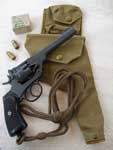
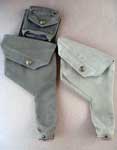 More details of the 1st issue Holster. The splendid picture far left shows Terry's Holster with his Webley Mk. VI, the type of revolver for which it was made, There has been quite a bit of discussion regarding the colour of this Holster, which has clearly not been blancoed, but seems to have a green, or olive shade instead of the expected khaki. Of course, after nearly 90 years, colour is always a questionable criterion, but in our experience Mills webbing doesn't usually turn green and darken like this. In the photo near left, Terry has shown his 1922 Holster next to a W.E. Pattern 1919 one. One suggestion is that this Holster may have been intended for the Irish Army, who ordered a substantial amount of W.E. Pattern 1908, in a special shade of green, in 1922-23.
More details of the 1st issue Holster. The splendid picture far left shows Terry's Holster with his Webley Mk. VI, the type of revolver for which it was made, There has been quite a bit of discussion regarding the colour of this Holster, which has clearly not been blancoed, but seems to have a green, or olive shade instead of the expected khaki. Of course, after nearly 90 years, colour is always a questionable criterion, but in our experience Mills webbing doesn't usually turn green and darken like this. In the photo near left, Terry has shown his 1922 Holster next to a W.E. Pattern 1919 one. One suggestion is that this Holster may have been intended for the Irish Army, who ordered a substantial amount of W.E. Pattern 1908, in a special shade of green, in 1922-23.
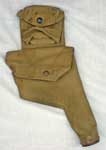
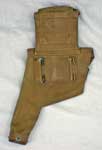 By 1927, the 2nd Issue had been introduced, with a box-lid fitted to the Pocket. This example is maker marked "M.E. Co." and dated 1927. From the Nick Wall Collection, photographs © Nick Wall 2009.
By 1927, the 2nd Issue had been introduced, with a box-lid fitted to the Pocket. This example is maker marked "M.E. Co." and dated 1927. From the Nick Wall Collection, photographs © Nick Wall 2009.


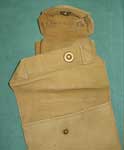 Another 2nd issue Holster, this one maker marked ""M.E. Co." and dated 1933. This presumably means that the transition from "cotton reel" to web muzzle cap took place 1933-35. Does one of our readers have a W.E.I.O. Holster that will narrow that gap? This example from the Graham Tweeddale Collection, photographs © Graham Tweeddale 2010.
Another 2nd issue Holster, this one maker marked ""M.E. Co." and dated 1933. This presumably means that the transition from "cotton reel" to web muzzle cap took place 1933-35. Does one of our readers have a W.E.I.O. Holster that will narrow that gap? This example from the Graham Tweeddale Collection, photographs © Graham Tweeddale 2010.
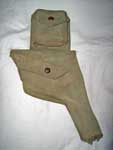
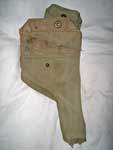
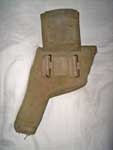 Around 1935, noted from other web Holsters, the “cotton reel” was abandoned for a 3rd Issue form. The circular section cotton reel was changed to a stiffened, ovaloid web muzzle cap. This 3rd issue Holster is maker marked "M.E. Co." and dated 1936. From the Chris Pollendine Collection, photographs © Chris Pollendine 2010.
Around 1935, noted from other web Holsters, the “cotton reel” was abandoned for a 3rd Issue form. The circular section cotton reel was changed to a stiffened, ovaloid web muzzle cap. This 3rd issue Holster is maker marked "M.E. Co." and dated 1936. From the Chris Pollendine Collection, photographs © Chris Pollendine 2010.
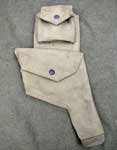
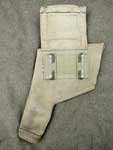 Another example, this one maker marked "M.E. Co." and dated 1937. Photos used by permission of WD Militaria.
Another example, this one maker marked "M.E. Co." and dated 1937. Photos used by permission of WD Militaria.
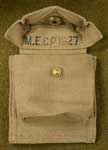
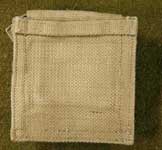 Just as happened with Binocular cases and Compass pockets, W.E.I.O. Holsters and Ammunition pouches were sometimes separated by their owners. Here is a 2nd issue Ammunition pouch that has been cut from its Holster. The marks from where the two parts were sewn together are visible at the bottom of the Pouch. It is maker marked "M.E. Co." and dated 1927. From the Jerry Lee Collection, photographs © Jerry Lee 2009.
Just as happened with Binocular cases and Compass pockets, W.E.I.O. Holsters and Ammunition pouches were sometimes separated by their owners. Here is a 2nd issue Ammunition pouch that has been cut from its Holster. The marks from where the two parts were sewn together are visible at the bottom of the Pouch. It is maker marked "M.E. Co." and dated 1927. From the Jerry Lee Collection, photographs © Jerry Lee 2009.
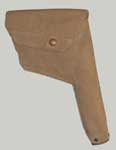
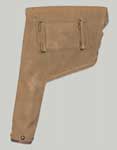
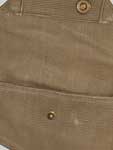 And here, the opposite side of the equation. This Pistol case has been parted from its Ammunition pouch. Interestingly, it appears to have never been used, raising the question of just why the two halves were separated. It is neither marker marked nor dated. The 1933 dated 2nd issue Case above was dated only in the lid of the Pouch, and this one may well have been marked the same way. Note the marks visible on the rear and inside the Pistol case, showing where it was sewn to the Ammunition pouch. From the Fausto Serra Collection, photos © Fausto Serra 2011.
And here, the opposite side of the equation. This Pistol case has been parted from its Ammunition pouch. Interestingly, it appears to have never been used, raising the question of just why the two halves were separated. It is neither marker marked nor dated. The 1933 dated 2nd issue Case above was dated only in the lid of the Pouch, and this one may well have been marked the same way. Note the marks visible on the rear and inside the Pistol case, showing where it was sewn to the Ammunition pouch. From the Fausto Serra Collection, photos © Fausto Serra 2011.
The series of photos above, taken by Terry Hawker, demonstrate that it is possible to load two standard boxes of 0.455-in. pistol ammunition, 12 rounds each, into the Ammunition pouch of his 1922 M.E. Co. 1st issue W.E.I.O. Holster. Photographs © Terry Hawker 2010.
HOLSTER, PISTOL, with POUCH, AMMUNITION, PISTOL (Enfield .380-in.)
The Enfield .380-in. Pistol, revolver, No. 2 was introduced as the issue pistol in 1932. Officers would be able to purchase the new pistol, or a near-equivalent from around this time. One example, dated 1936, has been noted of a smaller Case, pistol to accommodate the new standard of pistol. This example has actually been modified, for use with Patt. '37 W.E., as its "C" hooks have been transferred to the back of the Ammunition pouch. This is finished to the 3rd Issue standard of the .455-in. Holsters, but it is not known if an earlier example might exist, fitted with a “cotton reel”. Readers will hopefully fill in the gap?
